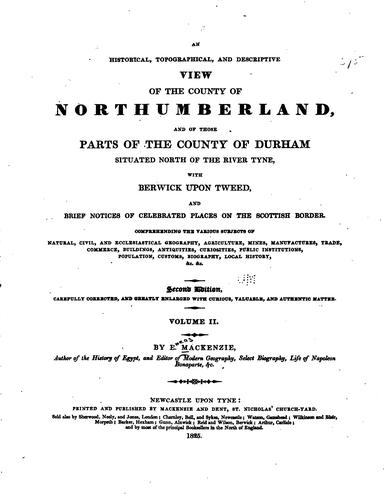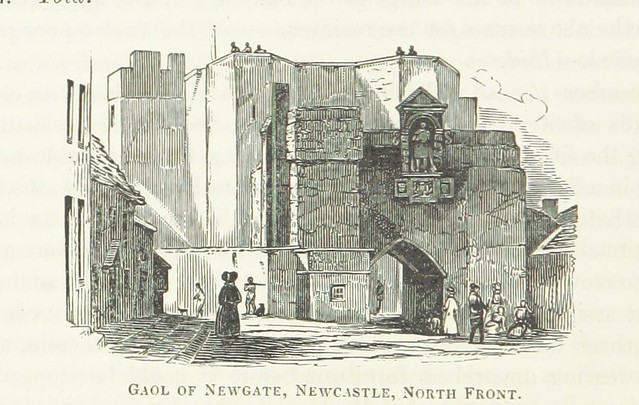Topics > Heritage Sites > Newcastle Town Walls > New Gate
New Gate
This was the largest and most important gate in the Medieval Town Wall of Newcastle, giving its name to todays Newgate Street. In 1390 it was strengthened by the addition of a barbican; from then on it became known as the Newgate. In 1399 it was turned into a prison. It was demolished in 1823. In 1827 Eneas Mackenzie wrote: "New Gate - From the name of this noble gate, we may infer that it has been erected on the site of an older one, which appears to have been called "Berwick Gate," and through which the bishop of Durham marched to join the English army that fought the Scots at Otterburn in 1388. This gate is, however, mentioned in 1390, with its present appellation. When Newcastle, in 1399, was made a county of itself, and took custody of its own prisoners, it became the common gaol of the town. Before this period, they were probably confined in the Castle. The south  front was evidently the most ancient part of the structure, and exhibited the same style of architecture, and the same aspect of strength and defiance, as the inner ward of Alnwick Castle. Bourne says, it "is not only the strongest, but also the most ancient, of all the other gates. It is of the same masonry and way of building with that part of the wall which leads to Westgate westward, as far as Ever Tower, which is visibly the oldest part of the wall." The wings to this front were only recent additions; the one being added in 1702, and the other in 1706. The north front, or gate, was intended as an outwork to the defences of the main gate, and had, like similar structures, a gallery on each side, from which furious and imprudent assailants who had passed the first entrance might be attacked. On this front were three ancient shields of arms:—St. George's cross; arms of England, with the fleurs de lis semée; and those of Newcastle upon Tyne. Above the entrance was a statue, resembling king James I. It was placed under an arch, had a crown and robes, held a sceptre in the right hand, and a globe in the left. It is now in the Castle. In 1765, a foot-way was opened through the town's wall, on the east side of the gate, for the convenience of the public, and which was considerably widened in 1811.
front was evidently the most ancient part of the structure, and exhibited the same style of architecture, and the same aspect of strength and defiance, as the inner ward of Alnwick Castle. Bourne says, it "is not only the strongest, but also the most ancient, of all the other gates. It is of the same masonry and way of building with that part of the wall which leads to Westgate westward, as far as Ever Tower, which is visibly the oldest part of the wall." The wings to this front were only recent additions; the one being added in 1702, and the other in 1706. The north front, or gate, was intended as an outwork to the defences of the main gate, and had, like similar structures, a gallery on each side, from which furious and imprudent assailants who had passed the first entrance might be attacked. On this front were three ancient shields of arms:—St. George's cross; arms of England, with the fleurs de lis semée; and those of Newcastle upon Tyne. Above the entrance was a statue, resembling king James I. It was placed under an arch, had a crown and robes, held a sceptre in the right hand, and a globe in the left. It is now in the Castle. In 1765, a foot-way was opened through the town's wall, on the east side of the gate, for the convenience of the public, and which was considerably widened in 1811.
 At the spring assizes in 1820, Newgate gaol was presented by the grand jury of the town and county, "as being out of repair, and inconvenient, insufficient, and insecure." An act was therefore obtained for building a new gaol; and the felons and debtors were successively removed, the former to the new prisons in the county courts, and the latter to the Castle. In June, 1823, workmen began to pull down the east wing of Newgate, which was followed by the removal of the west wing; and the north gate being also demolished, the most ancient part of the building became isolated. A vigorous, but unsuccessful effort was now made by the lovers of antiquity, to save this venerable monument of ancient times from destruction; but, in the following September, it also fell a sacrifice to the improving spirit of the age. Part of the walls were blasted with gunpowder; whilst other parts, on removing the facing stones, appeared like heaps of rubbish. The portcullis, which was found in a very perfect state, is now at Blagdon. During the demolition of this structure, several large cannon-balls were found, deep sunk in the wall. The above wood cut, by Nicholson, represents the south front of Newgate, with the guard-house adjoining its west wing, and the foot-way into Percy Street on the east side."
At the spring assizes in 1820, Newgate gaol was presented by the grand jury of the town and county, "as being out of repair, and inconvenient, insufficient, and insecure." An act was therefore obtained for building a new gaol; and the felons and debtors were successively removed, the former to the new prisons in the county courts, and the latter to the Castle. In June, 1823, workmen began to pull down the east wing of Newgate, which was followed by the removal of the west wing; and the north gate being also demolished, the most ancient part of the building became isolated. A vigorous, but unsuccessful effort was now made by the lovers of antiquity, to save this venerable monument of ancient times from destruction; but, in the following September, it also fell a sacrifice to the improving spirit of the age. Part of the walls were blasted with gunpowder; whilst other parts, on removing the facing stones, appeared like heaps of rubbish. The portcullis, which was found in a very perfect state, is now at Blagdon. During the demolition of this structure, several large cannon-balls were found, deep sunk in the wall. The above wood cut, by Nicholson, represents the south front of Newgate, with the guard-house adjoining its west wing, and the foot-way into Percy Street on the east side."

from Newcastle libraries (flickr)
003698:Newgate Town Walls Newcastle-Upon-Tyne C.1820
Pinned by Simon Cotterill

from http://twsitelines.info/SMR/1…
Tyne and Wear HER(1543): Newcastle town wall, New Gate
- "New Gate, the largest of the gates on the wall, gave access from the town to the north and north-west. It consisted of a three storey tower flat on the …
Added by
Simon Cotterill

from Flickr (flickr)
Plan of Newcstle upon Tyne showing path of Town Wall with gates and towers
Pinned by Simon Cotterill

from Newcastle libraries (flickr)
009113:Newgate Newcastle upon Tyne Unknown 1823
Pinned by Simon Cotterill

from https://openlibrary.org/works…
An historical, topographical, and descriptive view of the county of Northumberland. (Eneas Mackenzie, 1825)
- Digitised version of An historical, topographical, and descriptive view of the county of Northumberland and of those parts of the county of Durham situated north of the river Tyne, with …
Added by
Simon Cotterill

from Flickr (flickr)
Image taken from page 171 of '[Local records; or historical register of remarkable events which have occurred exclusively in the counties of Durham and Northumberland, town and county of Newcastle upon Tyne, and Berwick upon Tweed; with an obituary of per
Pinned by Simon Cotterill

from Flickr (flickr)
The South front of the Newgate, Newcastle, during demolition (1853)
Pinned by Simon Cotterill


from Newcastle libraries (flickr)
003698:Newgate Town Walls Newcastle-Upon-Tyne C.1820
Pinned by Simon Cotterill

from http://twsitelines.info/SMR/1…
Tyne and Wear HER(1543): Newcastle town wall, New Gate
- "New Gate, the largest of the gates on the wall, gave access from the town to the north and north-west. It consisted of a three storey tower flat on the …
Added by
Simon Cotterill

from Flickr (flickr)
Plan of Newcstle upon Tyne showing path of Town Wall with gates and towers
Pinned by Simon Cotterill

from Newcastle libraries (flickr)
009113:Newgate Newcastle upon Tyne Unknown 1823
Pinned by Simon Cotterill

from https://openlibrary.org/works…
An historical, topographical, and descriptive view of the county of Northumberland. (Eneas Mackenzie, 1825)
- Digitised version of An historical, topographical, and descriptive view of the county of Northumberland and of those parts of the county of Durham situated north of the river Tyne, with …
Added by
Simon Cotterill

from Flickr (flickr)
Image taken from page 171 of '[Local records; or historical register of remarkable events which have occurred exclusively in the counties of Durham and Northumberland, town and county of Newcastle upon Tyne, and Berwick upon Tweed; with an obituary of per
Pinned by Simon Cotterill

from Flickr (flickr)
The South front of the Newgate, Newcastle, during demolition (1853)
Pinned by Simon Cotterill














